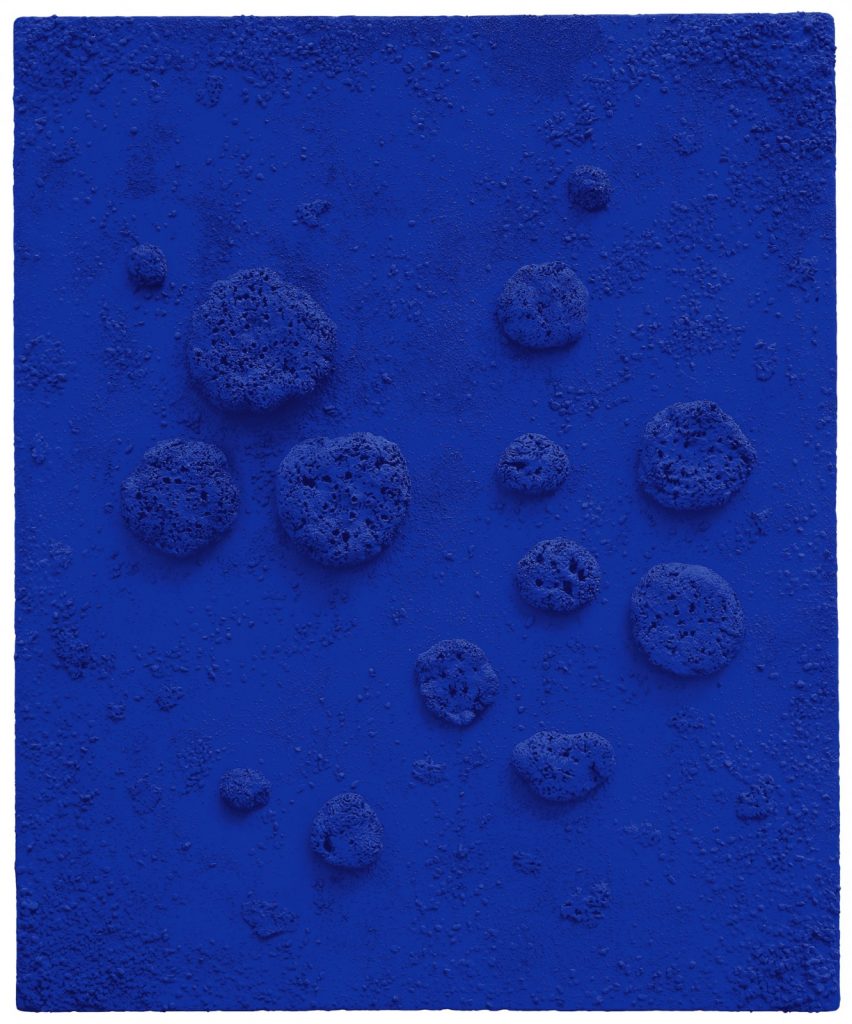The history of the colour blue
06.11.2018
Yves Klein - L'accord bleu (RE 010) , 1960 (Pigment pur et résine synthétique, éponges naturelles et cailloux sur panneau), Stedelijk Museum, Amsterdam
In the beginning the colour blue had the blues, it verged on black and nobody rated it. These days blue has reddish tones and everyone loves it. Colour is nothing without the look. The look is nothing without the society that shapes and even rules it. This is the story of the colour blue in the West.
More than an abstract (book or historical summary), this article will simply be a summary of the profound and scholarly work of historian Michel Pastoureau : Blue, History of a colour. Mr Pastoureau is an expert on colour, a subject that is very complex in history simply because the names of colours have changed without our knowing what they mean and because categorisations were quite different: so flowers we describe as blue such as iris, periwinkle and cornflower could be described in ancient Greece as « red (erythros), green (prasos) and black (melas) », begging the question as to whether the Greeks really took blue seriously at all! For sure they identified it but there was a big gap between the way it looked (primarily in biological terms) and their perception of it (highly cultural).
So this book with its comprehensive time line from prehistory to the present day requires knowledge of many fields: religious, political, literary, artistic, economic and technical histories. Colour is a sociological fact. Art and literature often only confirm the value of a colour that was first affirmed in the political, religious and social arena. Colour is always integrated with a value system (which evolves over a long period and varies within a given time frame depending on location and the issues at play around it).
A system of three colours, white, red and black, prevailed in Roman and Greek antiquity until the XIIth century in Europe. Hebrew, Aramaic and Greek described these colours « in terms of matter, light, density and quality ». Blue is hardly mentioned in the Bible. Later on, Latin descriptions of blue would prove inconsistent. Indigo dyes were used but the colour was probably not prized. Of course the fact that the Celts and Germans smeared blue on their bodies hardly helped its case.
Blue only became popular during the XIth century when it became associated with the Virgin Mary’s mourning. This blue, linked to the heavens, a new thing, appeared in Gothic stained glass windows. And from this point it jumped on to the coat of arms of the King of France as an azure shade (dark or light, it hardly mattered) behind the stylised lily motif. It gradually infiltrated chivalric stories by being linked to important characters and even became King Arthur’s colour. Before long blue became the ceremonial colour used in royal clothing. Slowly it became trendy. People wanted it. And its fortune was assured. The development of legislation for dyers, their statutes, conflicts and technical evolutions (woad, pastel blue…) that Pastoureau describes is most interesting.
From the XVth to the XVIIth century blue became associated with morality. It became the colour of honesty as sumptuary laws prescribed chromatic codes to denote status. Blue was the colour of respectability. But the ambition of a colour that wasn’t a colour was limitless. Heaven, kings, virtuous men, industrious folk enriched by their labours, all of that was still nothing. It needed love. It needed the world.
Techniques accelerated this evolution over the centuries, supporting the gradual enhancement of the colour blue by deepening it and stabilising it. But the appearance quite by chance of Prussian blue in the early XVIIIth century, a chemical process caused by a ruthless chemist of little principle (who made his fortune via a discovery not of his own making but induced by his dishonesty) was a great boost to the popularity of blue, first in art right until the Impressionists in the following century.
At the turn of the century Johann Wolfgang Goethe (1749-1832) gave blue a new dimension in his Treaty of Colours, perhaps the first anthropological approach to colour (even if its scientific pronouncements were incorrect): one of shadow, nostalgia, melancholy and coldness. And that’s how blue came hand-in-hand with Romanticism. Perhaps its sweetest and purest aspect is in the blue flower of Heinrich Von Ofterdingen’s dreams in the eponymous novel by Novalis. It darkest, blackest side would be born a century later but a contraction of the phrase « blue devils » : the blues.
But blue is dual. At the same time and without stopping it ends up on the American flag (proceeding from the English one going back to 1603) and then on the French flag. It took over military uniforms. Then then police, firemen and postmen. And then it became politicised and globalised by becoming a colour of peace: blue helmets just about sums that up. In short, even though blue is infused with black, it waves the white flag. And let’s not forget jeans, the way denim blue spread ubiquitously across all cultures.
Blue has blanketed the world, otherwise known as the blue planet. And this seems to be the springboard for a colour that was almost invisible in Antiquity (a silent colour) becoming omnipresent today: its neutral tone makes it perfect for all uses. Surveys say its an overwhelmingly popular colour. But again, this neutrality is probably not essential to the colour and remains an anthropological twist in the long term and something that is yet to evolve further. Blue may have had its glory days…

